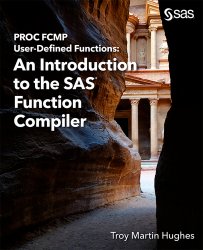PROC FCMP User-Defined Functions: An Introduction to the SAS Function Compiler
- Добавил: literator
- Дата: 15-04-2024, 19:42
- Комментариев: 0
 Название: PROC FCMP User-Defined Functions: An Introduction to the SAS Function Compiler
Название: PROC FCMP User-Defined Functions: An Introduction to the SAS Function CompilerАвтор: Troy Martin Hughes
Издательство: SAS Institute Inc.
Год: 2024
Страниц: 425
Язык: английский
Формат: pdf, epub
Размер: 10.1 MB
In PROC FCMP User-Defined Functions, readers are introduced to the SAS Function Compiler, which enables users to create user-defined functions and subroutines. These modular, callable software components complement the diverse array of SAS built-in functions and extend the SAS programming language, creating more building blocks for constructing future software!
The book opens by introducing the role of functions in software design and explaining how functions improve software quality characteristics. It then moves on to basic PROC FCMP syntax, including how to define and call user-defined functions. Next, readers learn about the SAS array and hash object, the primary data structures leveraged by PROC FCMP, and how PROC FCMP can manipulate them behind the scenes.
Finally, the Python Component Object is introduced, which facilitates the interoperability of SAS and Python. PROC FCMP runs Python functions natively inside a SAS wrapper, which allows open-source functions to be incorporated without needing to be rewritten in SAS.
PROC FCMP is a game changer. This book empowers readers to not only build better software, but also to embrace a more productive and efficient software development environment.
The Python language has become one of the most versatile, widely distributed programming languages in the world. Can I say that in a SAS book? Yes! Because the SAS Institute is not only aware of this success—they are capitalizing on it, as they continue their commitment to platform and software interoperability. The FCMP procedure helps facilitate the integration of Python and the SAS application through the Python Component Object, which enables Python functions to be executed inside user-defined SAS functions and subroutines.
Starting in SAS 9.4M6, the Python Component Object has supported the native execution of Python code inside the SAS application; that is, Python code that is run not by the SAS application, but rather by a locally installed Python interpreter. This functionality flexibly enables developers to run user-defined Python functions and select their preferred Python version, as well as preferred Python libraries and packages.
The Python Component Object supports two primary methods to import Python code into an object that is subsequently run in Python. Python code can be defined or created inside the FCMP procedure itself, or it can be defined inside an external program file that is called by the FCMP procedure. Both approaches effectively create a user-defined FCMP function that operates as a wrapper by encapsulating the inner Python function. Arguments passed to the user-defined FMCP function during invocation can subsequently be passed to the derivative Python function, allowing Python to provide the base functionality, after which the FCMP function returns values or other results to the calling program.
The Python Component Object is especially exciting because it allows Python developers to continue to develop within the integrated development environment (IDE) of their choosing (such as Spyder, Visual Studio Code, or old-school IDLE) and to take advantage of the inherent functionality of Python-specific IDEs. These benefits include automatic code highlighting, linting (static code analysis), autocorrection, and debugging, just to name a few familiar capabilities. Neither SAS developers nor Python developers are required to compromise in development best practices; they can all enjoy their comfortable IDEs, and in the end, the Python Component Object joins the collective modules into a cohesive software product.
Скачать PROC FCMP User-Defined Functions: An Introduction to the SAS Function Compiler
[related-news] [/related-news]
Внимание
Уважаемый посетитель, Вы зашли на сайт как незарегистрированный пользователь.
Мы рекомендуем Вам зарегистрироваться либо войти на сайт под своим именем.
Уважаемый посетитель, Вы зашли на сайт как незарегистрированный пользователь.
Мы рекомендуем Вам зарегистрироваться либо войти на сайт под своим именем.
